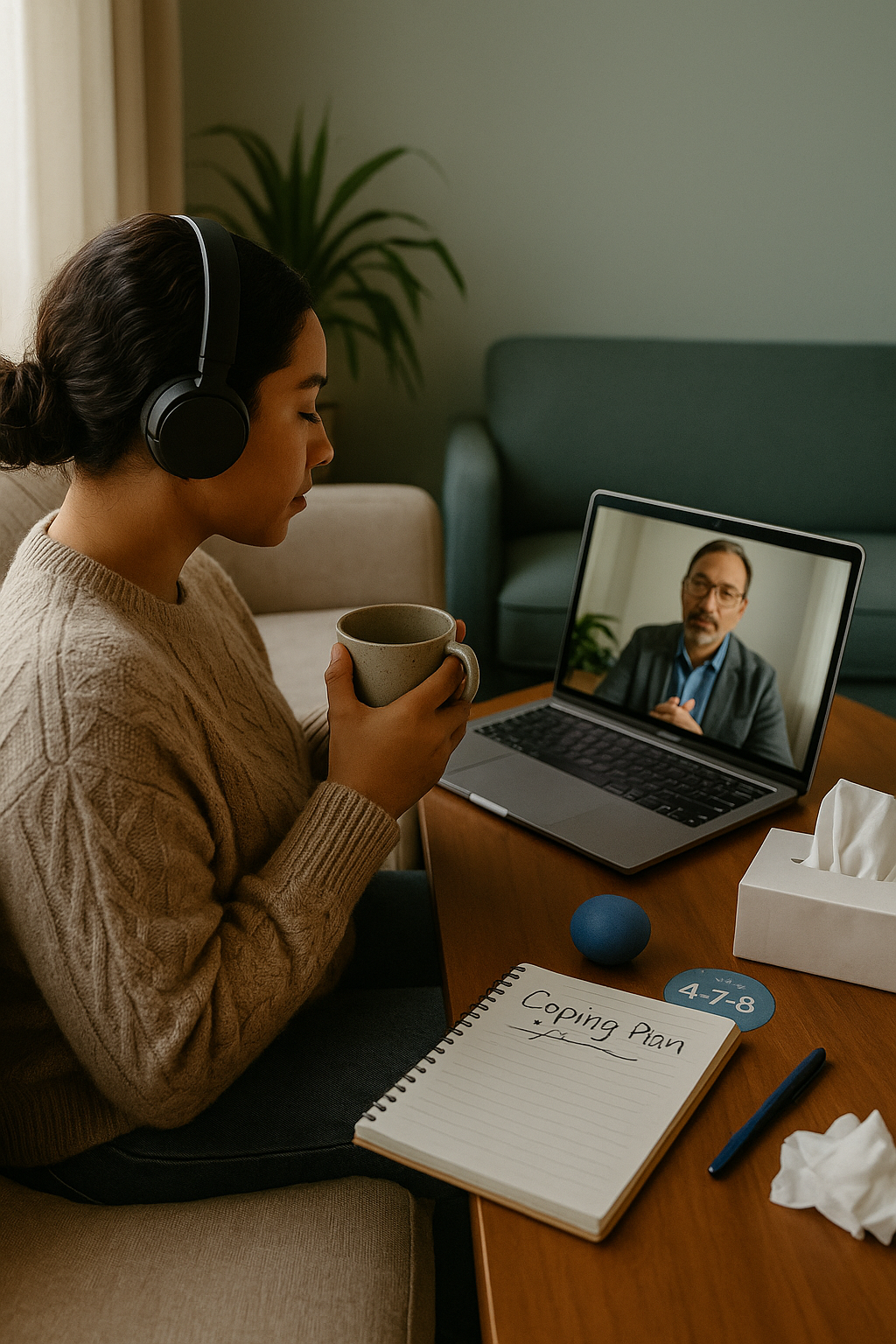Can I Talk to a Doctor About Anxiety Online?
- Home
- Can I Talk to a Doctor About Anxiety Online?

Can I Talk to a Doctor About Anxiety Online?
Estimated read time: 7–8 minutes
TL;DR: Yes. A telehealth clinician can assess your symptoms, rule out medical causes, provide coping tools, prescribe and adjust medications when appropriate, and connect you with therapy—all from home. If you’re in immediate danger or thinking about harming yourself, call 988 (US) or your local emergency number now.
What telehealth can do for anxiety
- Screen & diagnose: Guided questions plus short questionnaires (like GAD-7) help clarify the type and severity of anxiety.
- Rule out medical causes: Review of sleep, caffeine, thyroid issues, medications/substances, and when needed, basic labs or vital signs.
- Create a plan: Coping strategies for the next 24–72 hours, a longer-term therapy/medication plan, and clear follow-up timing.
- Prescribe/adjust meds (when appropriate): Many first-line medicines for anxiety and related conditions can be safely managed online with regular check-ins. Some drugs (especially controlled substances) may have extra rules and may require in-person evaluation.
- Therapy referrals: Connection to cognitive behavioral therapy (CBT), exposure therapy, trauma-focused therapy, or group programs.
- Coach the habits that help: Sleep routines, activity plans, caffeine/alcohol guidance, breathwork, and grounding skills.
- Documentation: Notes for work/school and short-term accommodations when needed.
Anxiety types telehealth commonly helps
- Generalized anxiety (persistent worry, muscle tension, poor sleep)
- Panic attacks and panic disorder
- Social anxiety
- Health anxiety
- Adjustment anxiety (after a major life change)
- Anxiety with depression (very common overlap)
Telehealth can also triage OCD, PTSD, bipolar disorder, or substance-related anxiety and guide you to the right specialty care.
What the first video visit is like
- Your story: When anxiety started, what it feels like, triggers, how it affects work/school/sleep/relationships.
- Screens & safety: Short questionnaires; gentle questions about mood, alcohol/other substances, and any thoughts of self-harm (so we can keep you safe).
- Body check-in: Caffeine, thyroid history, meds/supplements, physical symptoms (palpitations, chest tightness, shortness of breath, GI upset).
- Plan & options:
- Therapy: CBT/exposure skills, relaxation training, worry scheduling, thought reframing.
- Medication (if you want/need it): Discuss benefits/risks, side effects, and how long it takes to work.
- Skills to use today: A brief toolkit you can start immediately.
- Follow-up: Usually in 2–4 weeks to fine-tune; sooner if symptoms are severe or meds changed.
Medication basics (plain English)
- First-line options: SSRIs/SNRIs (e.g., sertraline, escitalopram, venlafaxine, etc.) or buspirone for some types of anxiety. These typically take 2–6 weeks to show full effect.
- Short-acting options: Antihistamines like hydroxyzine can help short-term anxiety or sleep.
- Benzodiazepines: Not first-line for most people due to dependence and falls/cognition risks, especially in older adults. If considered at all, they’re used carefully, short-term, and may require in-person evaluation depending on local rules.
- If you also have depression, PTSD, or chronic pain, your clinician may choose a medicine that helps more than one issue.
- Side effects & safety: You’ll get clear written instructions on what to expect, how to take doses, and what to do if you feel worse.
(Medication choices depend on your health history, other meds, pregnancy status, and preferences—your clinician will personalize this.)
Skills you can start today
- Box breathing 4-4-4-4: Inhale 4, hold 4, exhale 4, hold 4—repeat 2–3 minutes.
- Grounding 5-4-3-2-1: Name 5 things you see, 4 feel, 3 hear, 2 smell, 1 taste.
- Worry “office hours”: Set a 10-minute window daily to write worries, then return to your task.
- Sleep anchors: Same wake time daily; limit caffeine after noon; dim screens 1 hour before bed.
- Move daily: Even a 10–15 minute walk lowers arousal and improves sleep.
- Reduce triggers: Taper excess caffeine; review alcohol/cannabis use with your clinician.
- Connection: Share with one trusted person; schedule a brief call or walk.
How to prepare for your telehealth visit
- Top 3 concerns you want help with (e.g., panic at night, work meetings, constant worry).
- History list: past therapies/meds (what helped, what didn’t), medical problems, allergies, pregnancy status if relevant.
- Current meds/supplements (name, dose, time of day).
- Recent stressors & routines: sleep, caffeine/alcohol, exercise, big life changes.
- Vitals if you have them: blood pressure, heart rate, weight.
- Privacy plan: a quiet space, headphones, and a glass of water or tea.
When telehealth is not enough (act now)
Go in person or call emergency services if any of the following apply:
- Thoughts about hurting yourself or someone else, or you feel unsafe
- Severe chest pain, trouble breathing, or fainting (don’t assume it’s “just panic”)
- New confusion, hallucinations, or signs of dangerous withdrawal from alcohol/benzodiazepines
- Mania symptoms (days of little sleep, racing thoughts, risky behavior)
US crisis support: Call or text 988 to reach the Suicide & Crisis Lifeline, or use chat at 988lifeline.org. If outside the US, call your local emergency number or a local crisis line.
How SendClinic can help
- Same-day video visits for anxiety assessment and a personalized plan
- Therapy referrals (CBT/exposure) and self-help tools you can start now
- Medication management when appropriate, with clear written instructions
- Follow-ups every few weeks until you feel steady—then spaced out for maintenance
- Notes for work/school and simple check-ins to keep you on track
Educational content only. This article is not a substitute for medical advice. Always follow your clinician’s guidance and local emergency instructions.
- Share